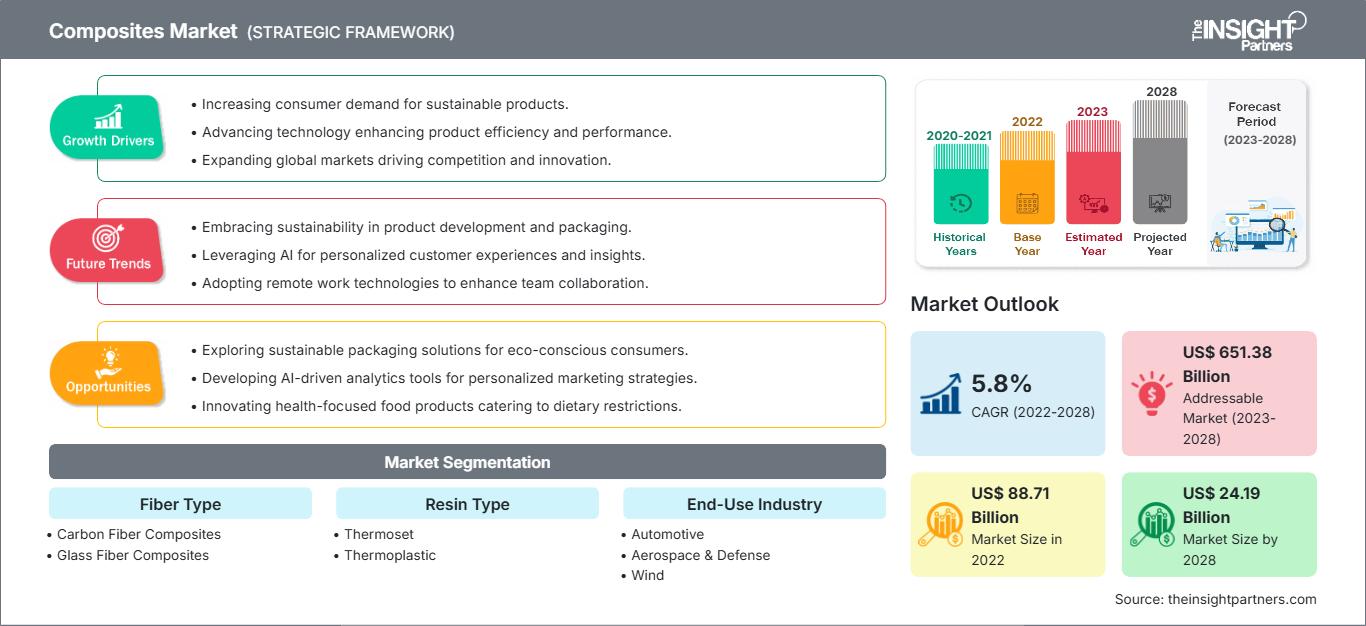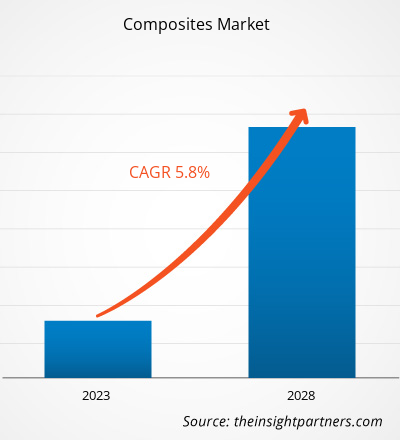Se espera que el tamaño del mercado de compuestos crezca de US$ 88.710,42 millones en 2022 a US$ 124.185,35 millones en 2028; se estima que crecerá a una CAGR del 5,8% entre 2022 y 2028.
Los materiales compuestos son ligeros en comparación con la mayoría de las maderas y metales. Esta ligereza hace que su uso sea importante en automóviles y aeronaves, donde un menor peso ofrece una mayor eficiencia de combustible. Hoy en día, los diseñadores de aviones se preocupan mucho por el peso, ya que al reducirlo, se reduce la cantidad de combustible que necesita y se aumenta la velocidad que puede alcanzar. Además, los materiales compuestos resisten los daños causados por la intemperie y los productos químicos agresivos. Se pueden moldear en formas complejas con mayor facilidad que la mayoría de los demás materiales.
En 2022, Asia Pacífico representó la mayor participación en los ingresos del mercado global de compuestos. La demanda de compuestos en Asia Pacífico está aumentando debido a su creciente uso en diversas industrias, como la automotriz, la energía eólica, la construcción, los artículos deportivos y muchas otras. El auge de la industria de la construcción contribuye significativamente al crecimiento del mercado de compuestos en la región. Asia Pacífico está experimentando un proceso de urbanización, junto con el aumento de la construcción de proyectos residenciales y comerciales. Además, el ingreso per cápita en la región ha aumentado, junto con el desarrollo de edificios residenciales asequibles. Esto ha resultado en una rápida urbanización en Asia Pacífico. Las políticas gubernamentales favorables para el desarrollo inmobiliario residencial en varios países de la región impulsaron la urbanización. Además, países como China e India se encuentran entre los cinco principales países del mundo con energía eólica instalada. Todos estos factores contribuyen positivamente al crecimiento del mercado de compuestos en la región.
Obtendrá personalización en cualquier informe, sin cargo, incluidas partes de este informe o análisis a nivel de país, paquete de datos de Excel, así como también grandes ofertas y descuentos para empresas emergentes y universidades.
Mercado de materiales compuestos: perspectivas estratégicas

-
Obtenga las principales tendencias clave del mercado de este informe.Esta muestra GRATUITA incluirá análisis de datos, desde tendencias del mercado hasta estimaciones y pronósticos.
Impacto de la pandemia de COVID-19 en el mercado de materiales compuestos
Industrias como la automotriz, aeroespacial, de la construcción, marítima y energética han sido las principales contribuyentes a la demanda de compuestos. En 2020, estas industrias tuvieron que reducir sus operaciones debido a las interrupciones en la cadena de valor causadas por el cierre de fronteras nacionales e internacionales. La escasez de mano de obra provocó la desaceleración de las operaciones de producción y distribución de compuestos. Las interrupciones en la cadena de suministro global y el cierre de las instalaciones de producción de resina provocaron un fuerte aumento en los precios de los compuestos. Los confinamientos impuestos por diferentes países en 2020 obstaculizaron la capacidad de las industrias para mantener los niveles de inventario. Además, las medidas sanitarias y otras precauciones contra la COVID-19 redujeron significativamente la capacidad de producción, lo que generó una escasez de inventario de compuestos. Sin embargo, en 2021, el mercado global comenzó a recuperarse de las pérdidas sufridas en 2020, ya que los gobiernos de diferentes países anunciaron la flexibilización de las restricciones sociales. Asimismo, el aumento de las tasas de vacunación contribuyó a la mejora de las condiciones generales en diferentes países, lo que generó entornos propicios para el progreso industrial y comercial. Según el Foro Económico Mundial, la pandemia de COVID-19 tiene el potencial de generar innovaciones en el diseño de viviendas y se espera que brinde nuevas oportunidades en el campo de la renovación de viviendas. Se proyecta que este factor genere oportunidades lucrativas para el crecimiento del mercado de materiales compuestos durante el período de pronóstico.
Perspectivas del mercado
Creciente demanda de materiales ligeros en la industria automotriz y aeroespacial
Los fabricantes de automóviles prefieren materiales ligeros para fabricar automóviles, garantizando al mismo tiempo la seguridad y el rendimiento. Estos materiales tienen un excelente potencial para aumentar la eficiencia del combustible. Una reducción del 10 % en el peso del vehículo puede resultar en una mejora del 6 % al 8 % en el ahorro de combustible. Materiales avanzados como los compuestos de fibra de carbono tienen el potencial de reducir el peso de los componentes automotrices entre un 50 % y un 75 %. La aplicación de compuestos en el sector automotriz continúa creciendo. Los compuestos plásticos tienen excelentes propiedades acústicas y térmicas en comparación con los compuestos de origen no renovable, lo que los hace ideales para las piezas interiores de los vehículos. Además, son adecuados para la fabricación de componentes interiores no estructurales, como rellenos de asientos, respaldos, tapizados de techo, paneles interiores y tableros. Además, los fabricantes de aeronaves se esfuerzan por ampliar las estructuras termoplásticas primarias en jets ejecutivos y aviones comerciales. Han sido pioneros en la adopción de termoplásticos reforzados con fibra larga.
Información sobre los tipos de fibra
Según el tipo de fibra, el mercado global de compuestos se segmenta en compuestos de fibra de carbono, compuestos de fibra de vidrio y otros. La cuota de mercado global de compuestos para el segmento de compuestos de fibra de vidrio fue la más grande en 2022. Los compuestos de fibra de vidrio se producen mediante diversas tecnologías de fabricación y se utilizan para una amplia gama de aplicaciones. Las fibras de vidrio presentan varias propiedades, a saber, alta resistencia, flexibilidad, durabilidad y resistencia al daño químico. Puede presentarse en forma de mechas, hebras cortadas, hilos, telas y esteras. Cada tipo de fibra de vidrio tiene propiedades distintas y se utiliza para diversas aplicaciones en forma de compuestos poliméricos. Los materiales compuestos de fibra de vidrio son altamente preferidos para aplicaciones industriales debido a sus características favorables, como alta relación resistencia-peso, buena estabilidad dimensional, buena resistencia al calor y la corrosión, buenas propiedades de aislamiento eléctrico, facilidad de fabricación y costo relativamente bajo.
Entre los principales actores del mercado global de compuestos se encuentran DuPont de Nemours Inc., Gurit Holding AG, Hexion Inc., Mitsubishi Chemical Holdings Corp., Nippon Electric Glass Co. Ltd., Owens Corning, SGL Carbon SE, Teijin Ltd., Solvay SA y Toray Industries Inc. Estos actores se centran en ofrecer productos de alta calidad para satisfacer la demanda de los clientes. También se centran en estrategias como la inversión en investigación y desarrollo y el lanzamiento de nuevos productos.
Informe destacado
- Tendencias progresivas de la industria en el mercado de compuestos para ayudar a los actores a desarrollar estrategias efectivas a largo plazo
- Estrategias de crecimiento empresarial adoptadas por los mercados desarrollados y en desarrollo
- Análisis cuantitativo del mercado de composites de 2020 a 2028
- Estimación de la demanda mundial de materiales compuestos
- Análisis de las cinco fuerzas de Porter para ilustrar la eficacia de los compradores y proveedores que operan en la industria
- Desarrollos recientes para comprender el escenario del mercado competitivo
- Tendencias y perspectivas del mercado, así como factores que impulsan y restringen el crecimiento del mercado de compuestos
- Asistencia en el proceso de toma de decisiones destacando las estrategias de mercado que sustentan el interés comercial, lo que conduce al crecimiento del mercado.
- El tamaño del mercado de materiales compuestos en varios nodos
- Descripción detallada y segmentación del mercado, así como la dinámica de la industria de los compuestos.
- El tamaño del mercado de materiales compuestos en varias regiones con prometedoras oportunidades de crecimiento
Perspectivas regionales del mercado de materiales compuestos
Los analistas de The Insight Partners han explicado detalladamente las tendencias regionales y los factores que influyen en el mercado de composites durante el período de pronóstico. Esta sección también analiza los segmentos y la geografía del mercado de composites en Norteamérica, Europa, Asia Pacífico, Oriente Medio y África, y Sudamérica y Centroamérica.
Alcance del informe del mercado de materiales compuestos
| Atributo del informe | Detalles |
|---|---|
| Tamaño del mercado en 2022 | US$ 88.71 mil millones |
| Tamaño del mercado en 2028 | US$ 24.19 mil millones |
| CAGR global (2022-2028) | 5,8% |
| Datos históricos | 2020-2021 |
| Período de pronóstico | 2023-2028 |
| Segmentos cubiertos |
Por tipo de fibra
|
| Regiones y países cubiertos |
América del norte
|
| Líderes del mercado y perfiles de empresas clave |
|
Densidad de actores del mercado de materiales compuestos: comprensión de su impacto en la dinámica empresarial
El mercado de composites está creciendo rápidamente, impulsado por la creciente demanda del usuario final debido a factores como la evolución de las preferencias del consumidor, los avances tecnológicos y un mayor conocimiento de los beneficios del producto. A medida que aumenta la demanda, las empresas amplían su oferta, innovan para satisfacer las necesidades del consumidor y aprovechan las tendencias emergentes, lo que impulsa aún más el crecimiento del mercado.

- Obtenga una descripción general de los principales actores clave del mercado de materiales compuestos
Mercado mundial de materiales compuestos
Según el tipo de fibra, el mercado global de compuestos se segmenta en compuestos de fibra de carbono, compuestos de fibra de vidrio y otros. Según el tipo de resina, el mercado global de compuestos se bifurca en termoestables y termoplásticos. El segmento de los termoestables se segmenta a su vez en poliéster, éster de vinilo, epoxi, poliuretano y otros. El segmento de los termoplásticos se subdivide en polipropileno, polietileno, cloruro de polivinilo, poliestireno, tereftalato de polietileno, policarbonato y otros. Según la industria de uso final, el mercado global de compuestos se segmenta en automoción, aeroespacial y defensa, eólico, construcción, naval, artículos deportivos y otros.
Perfiles de empresas
- DuPont de Nemours Inc
- Gurit Holding AG
- Hexion Inc
- Corporación Mitsubishi Chemical Holdings
- Nippon Electric Glass Co. Ltd.
- Owens Corning
- SGL Carbon SE
- Teijin Ltd
- Solvay SA
- Industrias Toray Inc.
- Análisis histórico (2 años), año base, pronóstico (7 años) con CAGR
- Análisis PEST y FODA
- Tamaño del mercado, valor/volumen: global, regional y nacional
- Industria y panorama competitivo
- Conjunto de datos de Excel
Informes recientes
Testimonios
Razón para comprar
- Toma de decisiones informada
- Comprensión de la dinámica del mercado
- Análisis competitivo
- Información sobre clientes
- Pronósticos del mercado
- Mitigación de riesgos
- Planificación estratégica
- Justificación de la inversión
- Identificación de mercados emergentes
- Mejora de las estrategias de marketing
- Impulso de la eficiencia operativa
- Alineación con las tendencias regulatorias






















 Obtenga una muestra gratuita para - Mercado de materiales compuestos
Obtenga una muestra gratuita para - Mercado de materiales compuestos